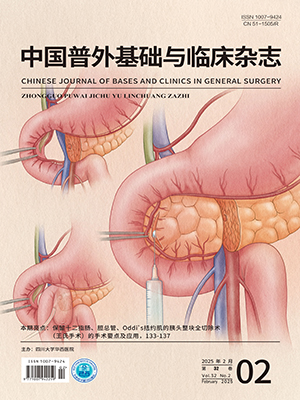| 1. |
Ryan DP, Hong TS, Bardeesy N. Pancreatic adenocarcinoma. N Engl J Med, 2014, 371(11): 1039-1049.
|
| 2. |
Bao G, Liu H, Ma Y, et al. The clinical efficacy and safety of different biliary drainages in malignant obstructive jaundice treatment. Am J Transl Res, 2021, 13(6): 7400-7405.
|
| 3. |
Qi S, Yan H. Effect of percutaneous transhepatic cholangial drainag+radiofrequency ablation combined with biliary stent implantation on the liver function of patients with cholangiocarcinoma complicated with malignant obstructive jaundice. Am J Transl Res, 2021, 13(3): 1817-1824.
|
| 4. |
Chandrashekhara SH, Gamanagatti S, Singh A, et al. Current status of percutaneous transhepatic biliary drainage in palliation of malignant obstructive jaundice: a review. Indian J Palliat Care, 2016, 22(4): 378-387.
|
| 5. |
Zerem E, Imširović B, Kunosić S, et al. Percutaneous biliary drainage for obstructive jaundice in patients with inoperable, malignant biliary obstruction. Clin Exp Hepatol, 2022, 8(1): 70-77.
|
| 6. |
Zhong JH, Huang DH, Chen ZY. Prognostic role of systemic immune-inflammation index in solid tumors: a systematic review and meta-analysis. Oncotarget, 2017, 8(43): 75381-75388.
|
| 7. |
Yang R, Chang Q, Meng X, et al. Prognostic value of systemic immune-inflammation index in cancer: a meta-analysis. J Cancer, 2018, 9(18): 3295-3302.
|
| 8. |
Guven DC, Sahin TK, Erul E, et al. The association between the pan-immune-inflammation value and cancer prognosis: a systematic review and meta-analysis. Cancers (Basel), 2022, 14(11): 2675. doi: 10.3390/cancers14112675.
|
| 9. |
Fest J, Ruiter R, Mulder M, et al. The systemic immune-inflammation index is associated with an increased risk of incident cancer—A population-based cohort study. Int J Cancer, 2020, 146(3): 692-698.
|
| 10. |
Yan L, Nakamura T, Casadei-Gardini A, et al. Long-term and short-term prognostic value of the prognostic nutritional index in cancer: a narrative review. Ann Transl Med, 2021, 9(21): 1630. doi: 10.21037/atm-21-4528.
|
| 11. |
Sun K, Chen S, Xu J, et al. The prognostic significance of the prognostic nutritional index in cancer: a systematic review and meta-analysis. J Cancer Res Clin Oncol, 2014, 140(9): 1537-1549.
|
| 12. |
Li J, Xu R, Hu DM, et al. Prognostic nutritional index predicts outcomes of patients after gastrectomy for cancer: a systematic review and meta-analysis of nonrandomized studies. Nutr Cancer, 2019, 71(4): 557-568.
|
| 13. |
徐川, 施海彬, 刘圣, 等. 低位恶性梗阻性黄疸242例介入引流治疗的预后分析. 介入放射学杂志, 2013, 22(2): 133-136.
|
| 14. |
Zhang GY, Li WT, Peng WJ, et al. Clinical outcomes and prediction of survival following percutaneous biliary drainage for malignant obstructive jaundice. Oncol Lett, 2014, 7(4): 1185-1190.
|
| 15. |
Wu J, Song L, Zhang Y, et al. Efficacy of percutaneous transhepatic cholangiodrainage (PTCD) in patients with unresectable pancreatic cancer. Tumour Biol, 2014, 35(3): 2753-2757.
|
| 16. |
Tang K, Sui LL, Xu G, et al. Effects of different palliative jaundice reducing methods on immunologic functions in patients with advanced malignant obstructive jaundice. Anticancer Res, 2017, 37(8): 4665-4670.
|
| 17. |
Wang HW, Li XJ, Li SJ, et al. Biliary stent combined with iodine-125 seed strand implantation in malignant obstructive jaundice. World J Clin Cases, 2021, 9(4): 801-811.
|
| 18. |
Saragih P, Makmun D, Kurniawan J, et al. One year survival of extrahepatic cholangiocarcinoma patients who did not undergo curative resection and paliative chemotherapy and its associated factors. Acta Med Indones, 2022, 54(1): 35-41.
|
| 19. |
许文娟, 马莹, 王译民, 等. 预后营养指数预测小细胞肺癌预后的临床应用研究. 四川大学学报(医学版), 2020, 51(4): 573-577.
|
| 20. |
Mao C, Xu W, Ma W, et al. Prognostic value of pretreatment prognostic nutritional index in patients with renal cell carcinoma: a meta-analysis. Front Oncol, 2021, 11: 719941. doi: 10.3389/fonc.2021.719941.
|
| 21. |
Shibutani M, Maeda K, Nagahara H, et al. The prognostic significance of the postoperative prognostic nutritional index in patients with colorectal cancer. BMC Cancer, 2015, 15: 521. doi: 10.1186/s12885-015-1537-x.
|
| 22. |
Jiang P, Li X, Wang S, et al. Prognostic significance of PNI in patients with pancreatic head cancer undergoing laparoscopic pancreaticoduodenectomy. Front Surg, 2022, 9: 897033. doi: 10.3389/fsurg.2022.897033.
|
| 23. |
Lv X, Zhang Z, Yuan W. Pretreatment Prognostic Nutritional Index (PNI) as a prognostic factor in patients with biliary tract cancer: a meta-analysis. Nutr cancer, 2021, 73(10): 1872-1881.
|
| 24. |
Shimizu T, Taniguchi K, Asakuma M, et al. Lymphocyte-to-monocyte ratio and prognostic nutritional index predict poor prognosis in patients on chemotherapy for unresectable pancreatic cancer. Anticancer res, 2019, 39(4): 2169-2176.
|
| 25. |
Yarmohammadi H, Covey AM. Percutaneous biliary interventions and complications in malignant bile duct obstruction. Chin Clin Oncol, 2016, 5(5): 68. doi: 10.21037/cco.2016.10.07.
|
| 26. |
Moole H, Bechtold ML, Cashman M, et al. Covered versus uncovered self-expandable metal stents for malignant biliary strictures: a meta-analysis and systematic review. Indian J Gastroenter, 2016, 35(5): 323-330.
|
| 27. |
Shabunin AV, Tavobilov MM, Lebedev SS, et al. Mechanisms and prevention of biliary stent occlusion. Khirurgiia (Mosk), 2020, (5): 70-75.
|
| 28. |
王卫国, 戴正行, 陈超波, 等. 经皮经肝胆管穿刺引流术联合胆道支架治疗恶性梗阻性黄疸的临床效果. 中国现代医药杂志, 2022, 24(5): 39-42.
|




